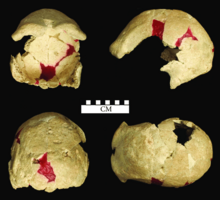WLH-50
This article has multiple issues. Please help improve it or discuss these issues on the talk page. (Learn how and when to remove these template messages)
|
 WLH-50 skullcap | |
| Common name | WLH-50 |
|---|---|
| Species | Human |
| Age | 29,000 years |
| Place discovered | New South Wales, Australia |
| Date discovered | 1982 |
Fossil WLH-50 is a partial cranium fossil that was discovered in 1982,[1] in the Willandra Lakes Region of Australia and was reconstructed by Alan Thorne.[2] Based on its overall dimensions and the growth of cranial features, WLH-50 has been determined to be a male skullcap.[3] Speculation surrounds the exact age of this fossil hominid and a debate concerning its ancestry in relation to other late Pleistocene hominids, as well as Ngandong hominids due to their close resemblance to one another.[4]
Characteristics
It has been said that WLH-50 has many of the same features as Homo erectus, but some of WLH-50's most notable characteristics include:[5]
- Thick Brow ridge
- Unusually thick, dense cranial vault – 15–19 millimetres thick (supposed adaptation to Malaria)
- Cranial Capacity – 1590cc
- Extended Nuchal Area for muscle attachment
- Occipital bun
- Robust size
Determining age
The fossil was discovered in a lake basin that undergoes several drying phases throughout the year. These phases cause displacements in the surrounding sediment and stratigraphy, thus making it difficult to properly date the fossil. There have been many attempts in trying to accurately date WLH-50 some of which include:[6]
Radio carbon dating
In 1981 and 1982 the Australian National University radio carbon dating lab tested the carbonate that encrusted the bone, as well as a freshwater shell and found:
- Carbonate – 9050 ± 310 BP (calibrated to 9.5–11.1 thousand years old, 2-σ error)
- Freshwater shell – 14,380 ± 240 BP (calibrated to 16.5–18.0 thousand years old)
Electromagnetic spin resonance
In 1987, D.A. Caddie conducted ESR dating technique and calculated that the bone fragment was 29,000 ± 5,000 years old.
Spectrometry
Simpson and Grun reported in 1998 that the fossil was potentially 14,000 years old, according to gamma spectroscopy and thermal ionization mass spectrometry (TIMS)/Uranium-series dating.[7]
It has been suggested that the latter technique provides a minimum age for this fossil, due to the fact that uranium uptake begins following burial.
Replacement Theory vs. Multi-Regional Mode
An ongoing debate within paleoanthropology is whether to place Ngandong hominids as Homo sapiens.[5]
Replacement theory predicts that Late Pleistocene Africans and Levantines are direct ancestors of WHL-50 and that Ngandong hominids are not direct ancestors of WHL-50.
The Multi-regional model considers Pleistocene Africans, Levantines, and Ngandong possible ancestors to WHL-50, making Ngandong a H. sapiens.[2]
References
- ^ Stringer, C. (March 1998). "A metrical study of the WLH-50 calvaria". Journal of Human Evolution. 34 (3): 327–332. doi:10.1006/jhev.1997.0204. ISSN 0047-2484. PMID 9547459.
- ^ a b Hawks, J; Oh, S.; Hunley, K.; Dobson, S.; Cabana, G.; Daylu, P.; Wolpoff, M.H. (2000). "An Australian test of the recent African origin theory using the WLH-50 calvarium". Journal of Human Evolution. 39 (1): 1–22. doi:10.1006/jhev.1999.0384. PMID 10896810.
- ^ Wolpoff, Milford H.; Lee, Sang-Hee (September 2014). "WLH 50: How Australia Informs the Worldwide Pattern of Pleistocene Human Evolution". Paleo Anthropology: 505–564. doi:10.4207/PA.2014.ART88 (inactive 31 January 2024). ISSN 1545-0031.
{{cite journal}}: CS1 maint: DOI inactive as of January 2024 (link) - ^ Curnoe, Darren (January 2011). "A 150- Year Conundrum: Cranial Robusticity and Its Bearing on the Origin of Aboriginal Australians". International Journal of Evolutionary Biology. 2011: 1–18. doi:10.4061/2011/632484. PMC 3039414. PMID 21350636.
- ^ a b Hawks, J; Oh, S; Hunley, K; Dobson, S; Cabana, G; Dayalu, P; Wolpoff, M. H. (2000). "An Australasian test of the recent African origin theory using the WLH-50 calvarium". Journal of Human Evolution. 39 (1): 1–22. doi:10.1006/jhev.1999.0384. PMID 10896810.
- ^ Grün, R; Spooner, N; Magee, J; Thorne, A; Simpson, J; Yan, G; Mortimer, G (2011). "Stratigraphy and chronology of the WLH 50 human remains, Willandra Lakes World Heritage Area, Australia". Journal of Human Evolution. 60 (5): 597–604. doi:10.1016/j.jhevol.2010.12.001. PMID 21306757.
- ^ Grün, Rainer; Spooner, Nigel; Magee, John; Thorne, Alan; Simpson, John; Yan, Ge; Mortimer, Graham (May 2011). "Stratigraphy and chronology of the WLH 50 human remains, Willandra Lakes World Heritage Area, Australia". Journal of Human Evolution. 60 (5): 597–604. doi:10.1016/j.jhevol.2010.12.001. ISSN 1095-8606. PMID 21306757.
- CS1 maint: DOI inactive as of January 2024
- Articles with short description
- Short description matches Wikidata
- EngvarB from May 2014
- Use dmy dates from May 2014
- Articles lacking in-text citations from April 2014
- All articles lacking in-text citations
- Articles needing expert attention from April 2014
- All articles needing expert attention
- Archaeology articles needing expert attention
- Articles with multiple maintenance issues
- Prehistoric mammals of Australia
- Hominin fossils